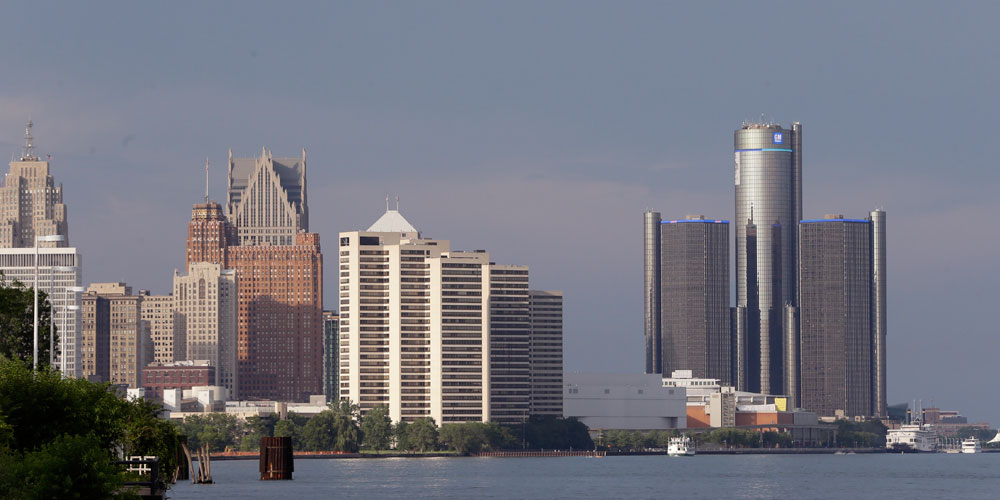
Detroit became the biggest US city to file for bankruptcy Thursday, its finances ravaged and its neighborhoods hollowed out by a long, slow decline in population and auto manufacturing that once made it the very symbol of American industrial might.
The federal bankruptcy court filing, which had been feared for months, conserves cash so the city can operate but it will hurt Detroit’s image for years. It could mean laying off municipal employees, selling off assets, raising fees and scaling back basic services such as trash collection and snow plowing, which have already been slashed.
Kevin Orr, a bankruptcy expert hired by the state of Michigan in March to stop Detroit’s fiscal free-fall, chose bankruptcy over diverting money from police, fire and other services to make debt payments. He made the filing in federal bankruptcy court under Chapter 9, the bankruptcy system for cities and counties.
Orr said Detroit would continue paying its bills and employees.
But, said Michael Sweet, a bankruptcy attorney in Fox-Rothschild’s San Francisco office, “They don’t have to pay anyone they don’t want to. And no one can sue them.”
“The Chapter 9 system creates a 90-day period during which all debts, interest payments and other are going to be frozen, to allow the negotiation of a final settlement which will result in reduction of debt,” Galileo Global Advisors CEO George Ugeux told FRANCE 24.
Industrial decline
It took decades of decay to bring down the industrial giant that put the world on wheels.
The city grew to 1.8 million people in the 1950s, luring them with plentiful jobs and paid good wages to stamp out automobile for sale across the globe. But like many American cities, Detroit’s fall began late that same decade as developers starting building suburbs.
At the same time, auto companies began opening plants in other cities, and the rise of autos imported from Japan started to cut the size of the US auto industry. Detroit’s property values fell, tax revenue dropped, police couldn’t control a growing murder rate, and many middle-class blacks fled the city for safer suburbs with better schools.
Detroit lost a quarter-million residents between 2000 and 2010. Today it’s barely above 700,000. Much of the middle-class and scores of businesses also have fled the city, taking their tax dollars with them.
The city is littered with abandoned factories built in the postwar boom years, most of which have multiple stories. As the Japanese auto invasion began cutting into Detroit’s sales, General Motors, Chrysler, Ford and hundreds of auto parts companies looked outside the city to build one-story plants that could handle modern assembly lines.
By the time the auto industry melted down in 2009, along with the economy as a whole, only a few factories from GM and Chrysler were left. GM is the only one with headquarters in Detroit.
Municipal trouble
Government corruption under former detroit Mayor Kwame Kilpatrick only made things worse. A jury convicted the once-popular mayor in March of racketeering conspiracy and other crimes after a trial that portrayed him as an unscrupulous political who took bribes and rigged contracts while in office until 2008.
The current mayor, former basketball great Dave Bing, announced in May that he wouldn’t seek a second term and angrily denounced Michigan officials for not giving him enough time to solve Detroit’s financial problems on his own.
In recent months, the city has relied on state-backed bond money to meet payroll for its 10,000 employees.
Orr was unable to persuade a host of creditors, unions and pension boards to take pennies on the dollar to help facilitate the city’s massive financial restructuring. If the bankruptcy filing is approved, city assets could be liquidated to satisfy demands for payment.
Michigan Gov. Rick Snyder determined earlier this year that Detroit was in a financial emergency and without a plan for improvement. He made it the largest US city to fall under state oversight when a state loan board hired Orr.
Recovering from bankruptcy?
A turnaround specialist, Orr represented automaker Chrysler LLC during its successful restructuring.
He laid out his plans in June meetings with debt holders, in which his team warned there was a 50-50 chance of a bankruptcy filing. The team said Detroit was defaulting on about $2.5 billion (€1.90 billion) in unsecured debt to “conserve cash” for police, fire and other services.
Detroit’s budget deficit is believed to be more than $380 million (€290 million). Orr has said long-term debt was more than $14 billion (€10.6 billion) and could be between $17 billion (€13 billion) and $20 billion (€15.2 billion).
Some are concerned that a bankrupt Detroit will cause businesses large and small to reconsider their operations in the city. But General Motors, which filed and emerged from bankruptcy, does not anticipate any impact to its daily operations, the automaker said Thursday in a statement.
“GM is proud to call Detroit home and today’s bankruptcy declaration is a day that we and others hoped would not come,” the statement said. “We believe, however, that today also can mark a clean start for the city.”
Detroit has more than double the population of the Northern California community of Stockton, California, which until Detroit had been the largest US city ever to file for bankruptcy when it did so in June 2012.

Leave your comment on this story